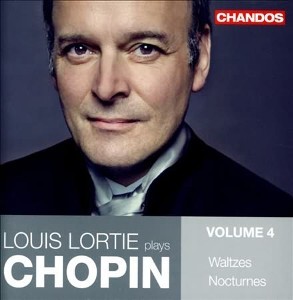The fourth volume of what promises to be a complete Chopin piano music survey from Louis Lortie contains five nocturnes and the 19 waltzes. Lortie devises a running order that mixes and matches the works to achieve variety and contrast. For example, the youthful E-flat waltz (the one that Michelangeli often played as an encore) emerges like a ray of sunshine following the wistfully lyrical B minor Op. 69 No. 2, while the short, lightheartedly flashy posthumous A-flat waltz serves as a cameo-like bridge between the grand, multithematic E-flat Op. 18 and A-flat Op. 34 No. 1 waltzes.
In general, Lortie is at his elegant best. He lovingly lingers over phrases in the posthumous A minor waltz as if he’s reluctant to let the bittersweet phrases go. As with the B-flat minor Op. 9 No. 1 nocturne, Lortie’s E minor waltz is supple and small of scale, in contrast to more dynamic, surging interpretations. Lortie’s brisk, liberally-pedaled F minor waltz imparts a floating, almost weightless character to the work. Similarly, the flexible, well-proportioned A minor Op. 34 No. 2 waltz never drags, and the F major Op. 34 No. 3’s “dog chasing its tail” right-hand runs are doled out with remarkable evenness and control.
The A-flat Op. 42 goes swimmingly by any standard, although a wider dynamic scope and bigger climaxes would have elevated the performance from memorable to irresistible. However, Lortie illuminates the B major Op. 32 No. 1 nocturne’s dark undercurrents by way of pronounced yet logical modifications of the basic pulse. His uptempo way with the A-flat Op. 64 No. 3 waltz reminds me a little of Rachmaninov’s similarly paced, poker-faced interpretation.
Of the two Op. 37 nocturnes, I prefer Lortie’s G minor for its introspective simplicity. The G major is quite pretty on the surface (the beautifully pointed chromatically descending notes in the left hand, for example), but Ashkenazy’s greater breadth and more incisive right-hand double notes get more out of the music. One also could imagine additional rhythmic kick to the central mazurka section in Lortie’s sensitively shaded posthumous C-sharp minor nocturne. The smooth and discreetly resonant engineering complements Lortie’s artistry. All told, this release is an enticing, albeit lower-voltage, alternative to recent Chopin waltz cycles from Stephen Hough and Alexandre Tharaud, with a generous 83-minute total playing time.
































